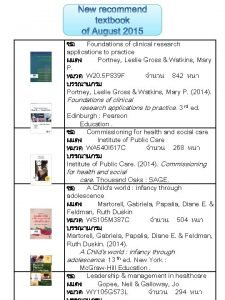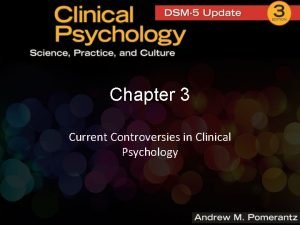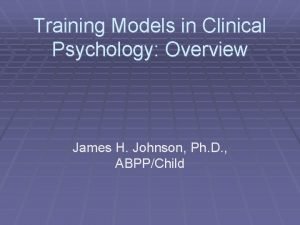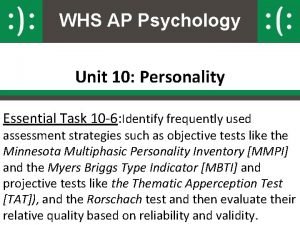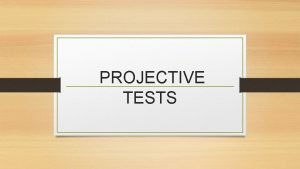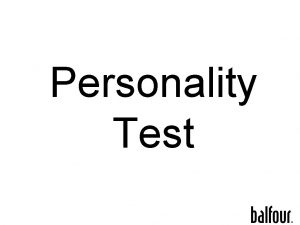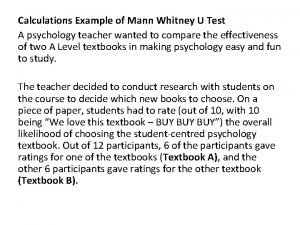NANTAI NVERSTES CLINICAL PSYCHOLOGY Test Applications in Clinical



































- Slides: 35

NİŞANTAŞI ÜNİVERSİTESİ CLINICAL PSYCHOLOGY Test Applications in Clinical Psychology İktisadi, İdari ve Sosyal Bilimler Fakültesi iisbf. nisantasi. edu. tr NİŞANTAŞI ÜNİVERSİTESİ ©

The Minnesota Multiphasic Personality Inventory (MMPI) is a psychological test that assesses personality ● DEFINITION The M M P I is currently commonly administered in one of two forms — the MMPI-2, which has 567 true/false questions, and the newer MMPI-2 -RF, published in 2008 and containing only 338 true/false items. traits and psychopathology. It is primarily intended to test people who are suspected of having M E N T A L H E A L T H or other C L I N I C A L I S S U E S.

PURPOSE The results of the MMPI-2 allow the test administrator to make inferences about the client's typical behaviors and way of thinking. The test outcomes help the examiner to determine the test taker's severity of impairment, outlook on life, approaches to problem solving, typical mood states, likely diagnoses, and potential problems in treatment. The MMPI-2 is used in a wide range of settings for a variety of procedures. The inventory is often used as part of inpatient psychiatric assessments, differential diagnosis, and outpatient evaluations. In addition, the instrument is often used by expert witnesses in forensic settings as part of an evaluation of a defendant's mental health, particularly in criminal cases.

EARLY HISTORY HATHAWAY 1940 s through 1950 s Hathaway and Mc. Kinley sought to develop an omnibus test instrument that would identify the presence of any of the major clinical syndromes utilized during the 1935– 1940 period. Psychiatric diagnosis at that time was based on Kraepelinian categories that had evolved to reflect psychodynamic theoretical constructs to varying degrees. MCKINLEY The initial diagnostic categories were Hypochondriasis, Depression, Hysteria, Psychopathic Deviate, Paranoia, Psychasthenia, Schizophrenia, and Hypomania. Subsequently, the Masculinity-Femininity and Social Introversion scales were added, resulting in the ten Clinical Scales that formed the core measures of the test until the RF was published in 2008.

EARLY HISTORY 1940 s through 1950 s Briefly, Hathaway and Mc. Kinley collected a large set of over 1, 000 items that was intended to be inclusive of all major symptoms of these syndromes. They reduced this to just over 500 items through rational judgment, and then administered the items to the group of 724 “Minnesota Normals” as well as sets of patients exhibiting the specific pathology at hand (the criterion groups). Items that exhibited a True-False proportion in the criterion group that differed significantly from the True-False proportion in the normative group were identified as members of the Clinical Scale for that syndrome. The references listed here are those that provide the most detail on this stage of the development of the test.

WHAT DOES THE MMPI-2 TEST? The MMPI-2 is designed with 10 clinical scales which assess 10 major categories The older MMPI-2 is made up 10 clinical subscales, which are a result of answering certain questions on the test in a specific manner: 1. Hypochondriasis (Hs) – The Hypochondriasis scale tapes a wide variety of vague and nonspecific complaints about bodily functioning. These complaints tend to focus on the abdomen and back, and they persist in the face of negative medical tests. There are two primary factors that this subscale measures — poor physical health and gastrointestinal difficulties. The scale contains 32 items.

WHAT DOES THE MMPI-2 TEST? The MMPI-2 is designed with 10 clinical scales which assess 10 major categories 2. Depression (D) – The Depression scale measures clinical depression, which is characterized by poor morale, lack of hope in the future, and a general dissatisfaction with one’s life. The scale contains 57 items.

WHAT DOES THE MMPI-2 TEST? The MMPI-2 is designed with 10 clinical scales which assess 10 major categories 3. Hysteria (Hy) – The Hysteria scale primarily measures five components — poor physical health, shyness, cynicism, headaches and neuroticism. The subscale contains 60 items.

WHAT DOES THE MMPI-2 TEST? The MMPI-2 is designed with 10 clinical scales which assess 10 major categories 4. Psychopathic Deviate (Pd) – The Psychopathic Deviate scale measures general social maladjustment and the absence of strongly pleasant experiences. The items on this scale tap into complaints about family and authority figures in general, self alienation, social alienation and boredom. The scale contains 50 items.

WHAT DOES THE MMPI-2 TEST? The MMPI-2 is designed with 10 clinical scales which assess 10 major categories 5. Masculinity/Femininity (Mf) – The Masculinity/Femininity scale measures interests in vocations and hobbies, aesthetic preferences, activity-passivity and personal sensitivity. It measures in a general sense how rigidly a person conforms to very stereotypical masculine or feminine roles. The scale contains 56 items.

WHAT DOES THE MMPI-2 TEST? The MMPI-2 is designed with 10 clinical scales which assess 10 major categories 6. Paranoia (Pa) – The Paranoia scale primarily measures interpersonal sensitivity, moral self-righteousness and suspiciousness. Some of the items used to score this scale are clearly psychotic in that they acknowledge the existence of paranoid and delusional thoughts. This scale has 40 items.

WHAT DOES THE MMPI-2 TEST? The MMPI-2 is designed with 10 clinical scales which assess 10 major categories 7. Psychasthenia (Pt) -The Psychasthenia scale is intended to measure a person’s inability to resist specific actions or thoughts, regardless of their maladaptive nature. “Psychasthenia” is an old term used to describe what we now call obsessive-compulsive disorder(OCD), or having obsessive-compulsive thoughts and behaviors. This scale also taps into abnormal fears, self-criticisms, difficulties in concentration and guilt feelings. This scale contains 48 items.

WHAT DOES THE MMPI-2 TEST? The MMPI-2 is designed with 10 clinical scales which assess 10 major categories 8. Schizophrenia (Sc) – The Schizophrenia scale measures bizarre thoughts, peculiar perceptions, social alienation, poor familial relationships, difficulties in concentration and impulse control, lack of deep interests, disturbing question of self-worth and self-identity, and sexual difficulties. This scale has 78 items, more than any other scale on the test.

WHAT DOES THE MMPI-2 TEST? The MMPI-2 is designed with 10 clinical scales which assess 10 major categories 9. Hypomania (Ma) – The Hypomania scale is intended to measure milder degrees of excitement, characterized by an elated but unstable mood, psychomotor excitement (e. g. , shaky hands) and flight of ideas (e. g. , an unstoppable string of ideas). The scale taps into overactivity — both behaviorally and cognitively — grandiosity, irritability and egocentricity. This scale contains 46 items.

WHAT DOES THE MMPI-2 TEST? The MMPI-2 is designed with 10 clinical scales which assess 10 major categories 10. Social Introversion (Si) – The Social Introversion scale measures the social introversion and extroversion of a person. A person who is a social introvert is uncomfortable in social interactions and typically withdraws from such interactions whenever possible. They may have limited social skills, or simply prefer to be alone or with a small group of friends. This scale has 69 items. While there are dozens of additional content scales that have been independently developed around the MMPI-2, these are the core 10 scales used by the test.


QUESTIONS LIKE THIS

THE FOUR VALIDITY SCALES The MMPI-2 is not a valid measure of a person’s psychopathology or behavior if the person taking the test does so in a way that is not honest or frank. A person may decide, for whatever reasons, to overreport (exaggerate) or underreport (deny) the behavior being assessed by the test. The Minnesota Multiphasic Personality Inventory-2 (MMPI-2) contains four validity scales designed to measure a person’s test-taking attitude and approach to the test: • Lie (L) – The Lie scale is intended to identify individuals who are deliberately trying to avoid answering the MMPI honestly and in a frank manner. The scale measures attitudes and practices that are culturally laudable, but rarely found in most people. In other words, people who make these items are often trying to make themselves look like a better person than they really are (or that anybody is). The scale contains 15 items. • K – The K scale is designed to identify psychopathology in people who otherwise would have profiles within the normal range. It measures selfcontrol, and family and interpersonal relationships, and people who score highly on this scale are often seen as being defensive. The scale contains 30 items.

THE FOUR VALIDITY SCALES The MMPI-2 is not a valid measure of a person’s psychopathology or behavior if the person taking the test does so in a way that is not honest or frank. A person may decide, for whatever reasons, to overreport (exaggerate) or underreport (deny) the behavior being assessed by the test. • F – The F scale (the “F” does not stand for anything, although it is mistakenly sometimes referred to as the Infrequency or Frequency scale) is intended to detect unusual or atypical ways of answering the test items, like if a person were to randomly fill out the test. It taps a number of strange thoughts, peculiar experiences, feelings of isolation and alienation, and a number of unlikely or contradictory beliefs, expectations and self-descriptions. If a person answers too many of the F and Fb scale items incorrectly, it will invalidate the entire test. Contrary to some descriptions of the scale, F scale items are scattered throughout the entire test up until around item 360. The scale contains 60 items. • Back F (Fb) – The Back F scale measures the same issues as the F scale, except only during the last half of the test. The scale has 40 items.

SCL-90

● Who Is Created ? ● Leonard R. Derogatis, Ph. D. After receiving his Ph. D. in psychology from Catholic University in 1965, Leonard R. Derogatis, Ph. D. began his academic career at the Biometrics Laboratory of George Washington University, where he worked on the design and analysis of NIMH-sponsored clinical drug trials. He subsequently accepted a position at the Johns Hopkins University School of Medicine in 1969 where he was on the faculty for 21 years, 12 of them as Director of the Division of Medical Psychology, and Chief Psychologist of the Johns Hopkins Hospital. In 2003, Dr. Derogatis became Director of the Johns Hopkins Center for Sexual Medicine, which was moved to the Center to Sheppard Pratt Hospital and Health System in Baltimore, Maryland in 2006.

● In 2012, Dr. Derogatis became the Director of the Maryland Center for Sexual Health. Over the past several decades, Dr. Derogatis has authored and published more than a dozen psychological test instruments, and has authored over 125 scientific papers. He has been the recipient of federal grant awards, including grants from NIMH and NCI, and has frequently served as principal investigator on industry sponsored multicenter clinical drug trials. His personal research is currently in the area of sexual medicine, where he is doing sponsored research on the screening, diagnosis and treatment of sexual disorders.

● Symptom Checklist-90 Revised (SCL-90 -R) ● The Symptom Checklist-90 Revised is a method to evaluate psychological problems and identify symptoms. This instrument is also used by psychologists, psychiatrists, mental health, medical, and educational professionals for monitoring the patient’s progress or treatment outcome.

● Participants are required to respond to the 90 items in the Symptom Checklist-90 Revised using a 5 -point rating scale. Approximately 12 -15 minutes is necessary for completion. Testing can be done with a computer, audio-cassette, or paper-and-pencil. Individual of 13 years or older are recommended for accurate test results. Another name for the Symptom Checklist-90 Revised is the Global Severity Index.

● The Symptom Checklist 90 -R (SCL-90 -R)is a widely applied selfassessment instrument for a broad range of mental disorders that assesses the subjective symptom burden in patients with mental disorders. Alongside the high acceptance and extensive worldwide application of the instrument as an outcome instrument in the treatment of patients with affective disorders, a number of studies have highlighted the psychometric weaknesses of the SCL-90 -R. A central criticism is that many studies were unable to replicate the postulated factor structure and instead found a general factor with large variance. This finding is relevant with regard to the practicality of the instrument because results on the factorial validity suggest partial redundancy of the collected data.

● The development of numerous short versions of the SCL-90 -R indicates the need for a more economic instrument. The short versions of the SCL-90 -R that have been developed include either a reduced number of items referencing the postulated factor structure, such as the Brief Symptom Inventory (BSI-53) and Brief Symptom Inventory-18 (BSI-18) , or a reduced item number with a reduced factor structure, such as the SCL-27 and SCL-14. Other SCL-90 -R short versions with a considerably reduced item number measure only a general severity factor, such as the SCL-K-9.

SUBSCALES ● ● ● ● ● Somatization Obsessive Comp. Interpers. Sensit. Depression Anxiety Hostility Phobic Anxiety Paranoid Ideat. Psychoticism Global Score

Reliability and Validity ● The Symptom Checklist-90 Revised is an established instrument and has over 1, 000 independent studies supporting is reliability and validity. The internal consistency coefficient rating ranged from 0. 90 for Depression and 0. 77 for Psychoticism. Test-retest reliability has been reported at 0. 80 to 0. 90 with a time interval of one week. All nine primary subscales are well correlated with the Minnesota Multiphasic Personality Inventory. The Symptom Checklist 90 Revised was also correlated with the IIP, 0. 73, and the SAS, 0. 69 (Pearson).

Beck Depression Inventory (BDI) ● ● ● The Beck Depression Inventory (BDI) is a commonly used instrument for quantifying levels of depression. The scale for the BDI was originally created by patients’ descriptions of their symptoms – mood, pessimism, sense of failure, self-dissatisfaction, guilt, suicidal ideas, crying, irritability, social withdrawal, insomnia, fatigue, appetite, weight loss, self-accusation. In the first portion of the test, psychological symptoms are assessed whereas the second portion assesses physical symptoms. The BDI test includes a 21 item self-report using a four-point scale ranging which ranges from 0 (symptom not present) to 3 (symptom very intense. The test takes approximately 5 to 10 minutes to complete. There is a shortened version of the test consisting of 7 items intended to by used by primary care providers. After the American Psychiatric Association (APA) published the Diagnostic and Statistical Manual of Mental Disorders Fourth Edition (DSM-IV), the Beck Depression Inventory (BDI) was revised in 1996 to reflect changes to the diagnostic criteria for Major Depressive Disorder, becoming the BDI-II. The BDI-II also contains 21 questions, scored from 0 to 3.

Validity and Reliability ● The BDI test is widely known and has been tested for content, concurrent, and construct validity. High concurrent validity ratings are given between the BDI and other depression instruments as the Minnesota Multiphasic Personality Inventory and the Hamilton Depression Scale; 0. 77 correlation rating was calculated when compared with inventory and psychiatric ratings. The BDI has also showed high construct validity with the medical symptoms it measures. Beck’s study reported a coefficient alpha rating of. 92 for outpatients and. 93 for college student samples. The BDI-II positively correlated with the Hamilton Depression Rating Scale, r = 0. 71, had a one-week test–retest reliability of r = 0. 93 and an internal consistency ? =. 91.

Beck Anxiety Inventory ● ● Statistics Solutions consists of a team of professional methodologists and statisticians that can assist the student or professional researcher in administering the survey instrument, collecting the data, conducting the analyses and explaining the results. The Beck Anxiety Inventory (BAI) discriminates between anxious and non-anxious groups. The inventory contains 21 items rated from 0 to 3 by the taker, with a total possible score of 63 points. The items are experiences related to anxiety such as “Fear of worst happening” or “Heart pounding/racing”. The Five to ten minutes is necessary for completing the test.

Validity and Reliability ● A sample of 83 patients whom had finished the Beck Anxiety Inventory after a week showed a average correlation with the items of. 60. Internal consistency was strong, over. 7, for the scale. The scale was compared with the HARS-R, HRSD-R, and the BDI scales. Correlation rating of. 51, . 25, and. 48 were calculated respectively with the scales listed. The Beck Anxiety Inventory is recommended for clinical and research settings in order to obtain the highest accuracy.

Interpretation ● ● ● Low anxiety. That is usually a good thing. However, it is possible that you might be unrealistic in either your assessment which would be denial or that you have learned to “mask” the symptoms commonly associated with anxiety. Too little “anxiety” could indicate that you are detached from yourself, others, or your environment. Moderate anxiety. Your body is trying to tell you something. Look for patterns as to when and why you experience the symptoms described above. For example, if it occurs prior to public speaking and your job requires a lot of presentations you may want to find ways to calm yourself before speaking or let others do some of the presentations. You may have some conflict issues that need to be resolved. Clearly, it is not “panic” time but you want to find ways to manage the stress you feel. High Anxiety is a potential cause for concern. Again, look for patterns or times when you tend to feel the symptoms you have circled. Persistent and high anxiety is not a sign of personal weakness or failure. It is, however, something that needs to be proactively treated or there could be significant impacts to you mentally and physically. You may want to consult a physician or counselor if the feelings persist.

Beck Hopelessness Scale ● ● ● The aim of this paper was to confirm the factor structure of the 20 -item Beck Hopelessness Scale in a non-clinical population. Previous research has highlighted a lack of clarity in its construct validity with regards to this population. Based on previous factor analytic findings from both clinical and non-clinical studies, 13 separate confirmatory factor models were specified and estimated using LISREL 8. 72 to test the one, two and three-factor models. Psychology and medical students at Queen’s University, Belfast (n = 581) completed both the BHS and the Beck Depression Inventory (BDI). All models showed reasonable fit, but only one, a four-item single-factor model demonstrated a non-significant chi-squared statistic. These four items can be used to derive a Short-Form BHS (SBHS) in which increasing scores (0– 4) corresponded with increasing scores in the BDI. The four items were also drawn from all three of Beck’s proposed triad, and included both positively and negatively scored items. This study in a UK undergraduate non-clinical population suggests that the BHS best measures a one-factor model of hopelessness. It appears that a shorter four-item scale can also measure this one-factor model.

REFERENCES 1. 2. 3. 4. 5. 6. Clinical Psychology: A Modern Health Profession 1 st Edition by Wolfgang Linden , Paul Hewitt , Nobel. Beck, A. T. , & Steer, R. A. (1984). Internal consistencies of the original and revised Beck Depression Inventory. Journal of Clinical Psychology, 40, 1365 -1367. Beck, A. T. , Steer, R. A. , Ball, R. , & Ranieri, W. (1996). Comparison of Beck Depression Inventories-IA and –II in psychiatric Allan, S. , & Gilbert, P. (1997). Submissive behaviour and psychopathology. Br. J. Clin. Psychol. , 36 (4), 467 -488. Clinical Psychology, Timothy J. Trull - Mitchell J. Prinstein, Wadsworth Publishing, (2012). Introduction To Clinical Psychology / Seventh Edition By Geoffrey P. Kramer, Douglas A. Bernstein, Vicky Phares NİŞANTAŞI ÜNİVERSİTESİ ©
 Nantai cash
Nantai cash Nantai 37
Nantai 37 Foundations of clinical research applications to practice
Foundations of clinical research applications to practice Nature and scope of clinical psychology
Nature and scope of clinical psychology Research design in clinical psychology
Research design in clinical psychology Current controversies in clinical psychology
Current controversies in clinical psychology Penn state university clinical psychology
Penn state university clinical psychology Clinical psychology definition
Clinical psychology definition Cultural issues in clinical psychology
Cultural issues in clinical psychology Models of clinical psychology
Models of clinical psychology Amber haque psychology
Amber haque psychology Psychology studies
Psychology studies Scope of clinical psychology
Scope of clinical psychology Doctorate in clinical psychology clearing house
Doctorate in clinical psychology clearing house Contemporary clinical psychology
Contemporary clinical psychology Clinical psychology science practice
Clinical psychology science practice Positive psychology ap psychology definition
Positive psychology ap psychology definition Social trap psychology definition
Social trap psychology definition Fundamental attribution error ap psychology
Fundamental attribution error ap psychology Social psychology is the scientific study of:
Social psychology is the scientific study of: Health psychology definition ap psychology
Health psychology definition ap psychology Ukcat test
Ukcat test Ucat anz practice test
Ucat anz practice test Tat test ap psychology
Tat test ap psychology Thematic apperception test scoring and interpretation
Thematic apperception test scoring and interpretation Rorschach test psychology definition
Rorschach test psychology definition Projective testing
Projective testing Myers pig personality test
Myers pig personality test Overjustification effect ap psychology
Overjustification effect ap psychology Two factor theory psychology
Two factor theory psychology Projective test ap psychology definition
Projective test ap psychology definition Mann whitney test psychology
Mann whitney test psychology Intellectual disability ap psychology
Intellectual disability ap psychology Ap psychology unit 1 test
Ap psychology unit 1 test Baterai tes psikologi adalah
Baterai tes psikologi adalah Ap psychology unit 8 test
Ap psychology unit 8 test


